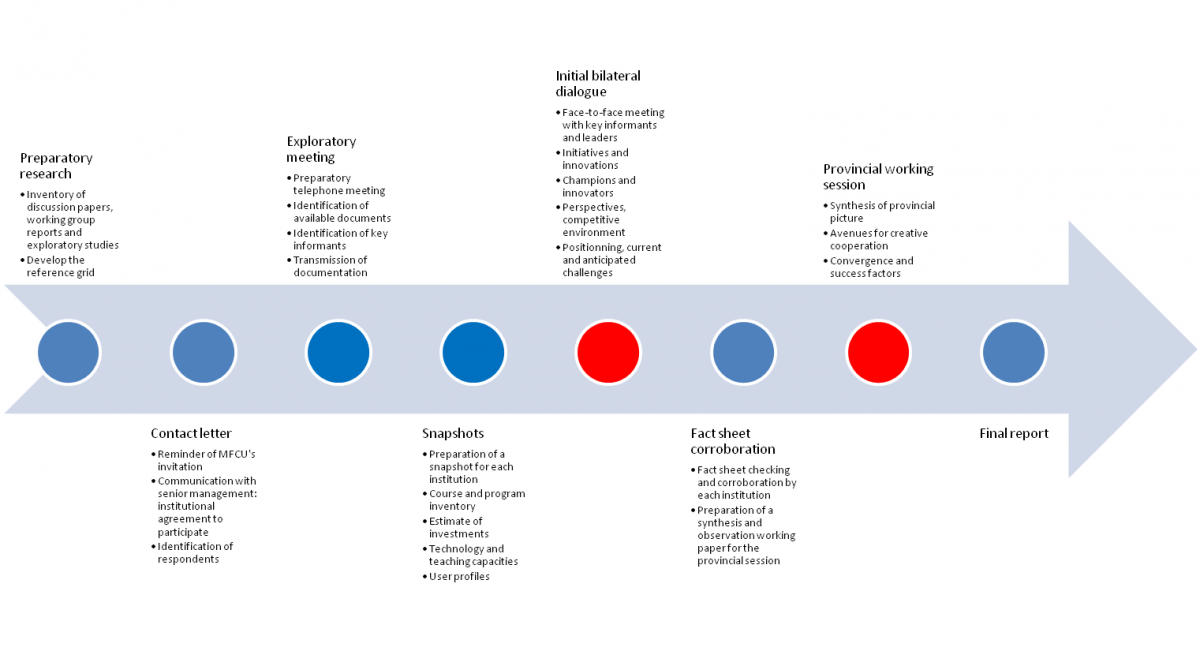In July 2013, the French-language Education Policy and Programs Branch (FLEPPB) of the Ontario Ministry of Training, Colleges and Universities and the Ontario Ministry of Education invited the bilingual and French-language educational partners of the Politique d’aménagement linguistique (PAL) to develop a collaborative and integrated approach to technology-assisted and online learning for Ontario’s French-language and bilingual postsecondary education institutions. FLEPPB pointed out that the Ontario Government had set a target of 70% of adults in the province obtaining postsecondary education credentials. To achieve this, the postsecondary education system has to become “accessible to a non-traditional student clientele or more flexible and more accommodating towards adult learners and potential students from groups that do not easily reach higher education levels.”
The FLEPPB retained the services of Contact North | Contact Nord “in order to develop, in consultation with the postsecondary education sector, an integrated model and concerted approach to online learning in Ontario’s French and bilingual postsecondary educational institutions.”
Stage 1
In this first stage, letters were sent to senior management at PAL partners, inviting them to participate in the consultation process and designate a representative. During the round of phone interviews with each institution, challenges and concerns were identified and defined.
An information-gathering template was then sent to each institution in November 2013, the purpose of which was to:
- Prepare an inventory of current and/or planned initiatives for French-language online learning;
- Estimate the size of current investments;
- Quantify existing technological and educational capacities;
- Identify the pool of specialized human resources;
- Itemize the current program and course offering;
- Develop a profile of users;
- Describe the institution’s initiatives and innovations;
- Identify champions and successful innovators;
- Gather leaders’ views on technology-assisted learning and the development of the competitive environment; and
- Understand their positioning as well as current and anticipated challenges.
Stage 2
During this stage, face-to-face, in situ meetings with each institution took place in January and February 2014. These meetings aimed at creating snapshots of their individual development and innovations in technology-assisted and online learning, and exploring areas where interests converged. A fact sheet was completed after each interview and validated by the institution. These detailed fact sheets are found in a document that accompanies this report.
Stage 3
In this final stage, a working session was held on February 28, 2014 at which an overall status summary was presented, and the detailed fact sheets were shared. This dialogue process, which involved the 12 PAL institutions and the FLEPPB representatives, validated the conclusions and identified common areas of interest and the conditions for a successful collaborative and integrated approach to online learning in the Ontario’s postsecondary French-language and bilingual educational institutions.
The figure below shows the main activities.
The following five elements were identified during preliminary consultations as a background to the collaborative process:
- Postsecondary institutions differ from each other due to their individual history, size and means at their disposal to launch new initiatives. These disparities are particularly important in any consideration of a collaborative and integrated approach as they imply variable pressures on partner resources and can produce concerns about imbalance in working relationships. Nonetheless, all participating institutions are broadly experienced in inter-institutional cooperation, both within Canada and abroad.
- Disruptions to institutional financial models seem inevitable and are a source of concern. The institutions are conscious of their position in the Francophone community and in the provincial marketplace, and are fully aware of the positions of their partners – who may also be their competitors. The technology-assisted and online learning business model remains to be completed, in terms of provincial funding formulas, student mobility, transferability and the potential for generated income.
- Cooperation starts from a neutral point, as there is no sense of urgency or crisis to compel change. There is no sense of imminent danger from a revolutionary transformation of the teaching and/or learning process, nor from new foreign or Canadian rivals gaining dominance, necessitating the development of defensive alliances.
- A variety of provincial government initiatives have led to a kind of “white noise, wait-and-see” policy amongst the institutions. The deadlines for developing proposals are very tight and do not encourage meaningful dialogue, creative responses or genuine collaboration. Moreover, challenges to Francophone populations and institutions are not clearly identified or specifically supported within these initiatives.
- The current offering of complete online programs in French is minimal as compared to the availability in English. Online learning is not identified as a priority for increasing the availability of programs or improving access to the institutions. Technology-assisted learning, often in the form of hybrid courses (blended learning), has become the preferred choice of most institutions.

